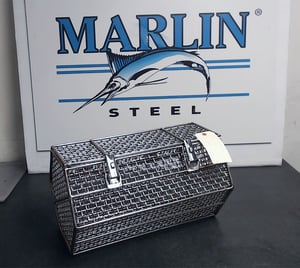 Marlin Steel often uses different alloys of stainless steel for its custom wire baskets and sheet metal forms. The properties of stainless steel make it an excellent material for many applications. However, with so many different types of stainless steel alloys available, it can often be difficult to generalize about the metal.
Marlin Steel often uses different alloys of stainless steel for its custom wire baskets and sheet metal forms. The properties of stainless steel make it an excellent material for many applications. However, with so many different types of stainless steel alloys available, it can often be difficult to generalize about the metal.
What are some stainless steel properties that you should know before you use one of these alloys? Here’s a quick explanation of different stainless steel grades and their properties:
Which Stainless Steel Properties Should I Know?
There are many different properties of stainless steel to consider, but the most important ones tend to be:
- Tensile Strength. The weight that the alloy can take before it starts to lose shape.
- Temperature Tolerance. The temperatures at which the stainless steel can be used safely without risk of compromising its performance.
- Corrosion Resistance. The protective oxide layer is a primary characteristic of all stainless steel grades—making them more resistant to oxidation and corrosion than plain steel.
- Shear Modulus. A measure of how much force is required to deform a metal. Higher shear modulus values indicate a tougher material that is less likely to bend under stress.
These are the characteristics of stainless steel that are the most frequently tested by manufacturing processes.
Why Do These Stainless Steel Properties Matter?
Tensile strength has a direct impact on the weight capacity of a custom wire basket. The higher the tensile strength of a stainless steel alloy, the more weight it can hold. Many stainless steel grades have excellent tensile strength—particularly carbon-rich stainless steel alloys. Another benefit of using high-strength stainless steel grades is that parts washing baskets can be made with very thin wires that minimize interference with the wash process without compromising the basket’s integrity.
Temperature tolerance is often important in manufacturing applications involving the use of extreme temperatures. For example, many heat treat applications involve the use of temperatures in excess of 1,000˚F or even 1,500˚F, well above the melting point of many polymers. This is one area where different grades of stainless steel may have vastly different performance characteristics.
Corrosion resistance can be hard to quantify concisely, because there are so many different chemicals and conditions that can contribute to corrosion—and some grades of stainless steel might handle specific corrosives better than others. For example, grade 316 stainless steel is more resistant to chlorides such as salt than grade 304 stainless steel. In general, stainless steel alloys tend to have excellent corrosion resistance overall when compared to plain steel.
Shear modulus is useful knowledge for understanding how well different stainless steel grades can take an impact. If a manufacturing application involves the use of machinery that delivers major impacts, or a risk of accidental drops, a higher shear modulus can make for a more resilient basket that will have a longer useful life.
Examples of Stainless Steel Properties by Grade
|
Stainless Steel Grade |
Tensile Strength |
Melting Point |
Corrosion Resistance |
Shear Modulus |
|
Grade 304 SS |
505 MPa |
1,400-1,455˚C |
Good vs most corrosives |
86 GPa |
|
Grade 316 SS |
580 MPa |
1,370-1,400˚C |
Excellent vs Chlorides |
74 GPa |
|
Grade 430 SS |
483 MPa |
1,426-1,510˚C |
Resists nitric acid |
81 GPa |
Note that there may be some variance in the performance values listed in the table. This is because of minute differences in individual batches of each alloy. A minor change in the carbon, chromium, molybdenum, or iron content of a stainless steel can alter its performance characteristics.
Need help choosing the right stainless steel grade for your processing equipment? Marlin Steel’s team of engineers has years of experience in matching the perfect material to your needs!



.gif)


